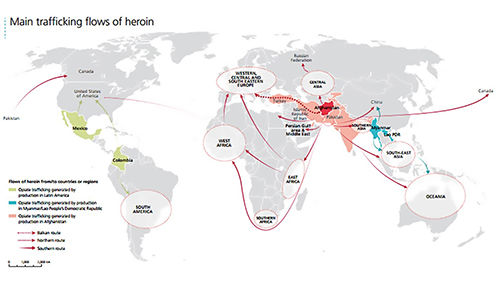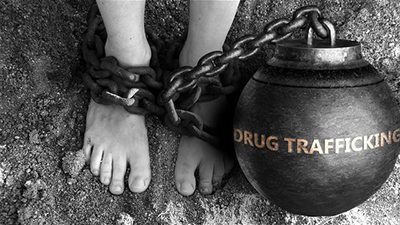Relevance: GS-3: Security challenges and their management in border areas; linkages of organized crime with terrorism.
Key Phrases: United Nations Office on Drugs and Crime (UNDOC), narcotics trafficking, opium and heroin trafficking, drug trafficking, Golden Crescent, Golden Triangle, illicit opium production.
Why in News?
- In 2021 the volume of intercepted heroin and hashish had doubled over the last year, from 2.3 tonnes in 2020 to 4 tonnes in 2021. These narcotics are cultivated, produced, and trafficked primarily from Afghanistan.
- The United Nations Office on Drugs and Crime (UNDOC) estimates that 80 percent of the world’s opium and heroin supplies are trafficked from Afghanistan along three primary routes into greater Asia and Europe, and pose a serious threat to the health and safety of citizens in these regions.
A Historical Background:
- In late 1999, the Taliban issued a ban on poppy cultivation that resulted in the largest reduction of opium poppy cultivation in a country in any single year.
- The ban did not last long and the Taliban rescinded the ban in September 2001, arguing they needed the financial resources to fight the US.
- After the stabilization of the coalition-backed government in Afghanistan in the late 2000s and early 2010s, the government in Kabul was able to look at more issues, including the massive poppy cultivation.
- Some fields were burnt and large-scale seizures were carried out, and yet multiple routes of drug trafficking remained active.
- Return of Taliban:
- They have reinstated the ban on the cultivation of poppies and the production, use, and transportation of other narcotics.
- It cannot be said with certainty how successful they want to be, considering how some in the Taliban were still using opium to fund their insurgency right until the American withdrawal from Kabul at the least.
US efforts in Afghanistan:
- The US alone spent over US$8 billion from 2012 to 2017 on just trying to eradicate the Afghan Poppy, according to a report by SIGAR.
- To achieve their goals, they believed they needed to eliminate the Taliban’s financing, much of which came from illegal opium harvesting and trafficking.
- Though the US and NATO-backed forces continued to engage in operations to destroy the illegal narcotics infrastructure as it were, it could never completely eradicate poppy from Afghan fields.
Impact of Ukrainian Crisis:
- This has led to a large number of western sanctions on Russia.
- Apart from the fact that this is leading to the loss of thousands of jobs, it could also lead to the resurgence of Russia as the piracy capital of the world, and could fuel the return of organized crime in Russia on a large scale controlling a black market for western goods.
- The excessive government spending on the military has resulted in funds being diverted from other important programs, such as those which counter narcotics trafficking.
Mapping “highways”: Trafficking routes for illicit drugs:
- Historically, Afghanistan, Pakistan, and Eastern Iran formed the “Golden Crescent”, one of Asia’s two principal areas of illicit opium production (the other being the Golden Triangle).
- There have always been multiple routes for traffickers to smuggle illicit opium and other narcotics from Afghanistan along the prominent Silk Road.
- One of these major routes leads through the Central Asian nations to Russia and Belarus, into the wider European market.

- The so-called “Northern route” from Afghanistan through Central Asia into Russia and Eastern Europe has historically been utilized for narcotrafficking, becoming an important route for various parties pushing Afghan heroin into Europe.
- According to the UNODC, in 2010, around 15 percent of all opiates, and 20 percent of all heroin from Afghanistan were trafficked through Tajikistan.
- However, through the concerted efforts of the UNODC and various governments in partnership with Central Asian countries, the route leading through Central Asia has been, though not insignificant, controlled since the inception of the Paris Pact Initiative in 2003.
- There have been varying levels of success and failure for the many Central Asian nations, and it remains overshadowed by other routes, including the primary “Balkan Route”.
- Turkmenistan, uniquely, has been a destination country for Afghan opiates being smuggled to Europe through the Balkan route.

Reasons for failure to curb drug trafficking:
- Lack the human and technical means to effectively intercept the majority of narcotics being smuggled.
- Meagre salaries make border forces susceptible to corruption, and their inadequate resources mean that they have a little option if threatened by powerful narcotics traffickers who have no qualms about using violence or force to achieve their objectives.
- Authoritarian and corrupt states have bred the narcotrafficking industry in the Central Asian region.
- The value of narcotics trafficked through Tajikistan in 2011 was estimated at the US $2.7 billion, far exceeding any source of legitimate wealth in the country. Such a valuable industry cannot exist without significant patronage from within the government and governmental institutions.
- The UNODC’s threat assessment for the region in 2012 contested that resources that could be used to counter narcotics trafficking were being diverted to suppress the people.
What needs to be done?
- The UNODC has spent considerable time and resources, developing various agreements and initiatives such as the Central Asian Regional Information and Coordination Centre for Combating Illicit Trafficking of Narcotic Drugs, Psychotropic Substances and their Precursors (CARICC), to combat the threat of drug trafficking in Central Asia to prevent it turning into a full-blown crisis.
- The Central Asian Countries and Russia should begin considering new regional and national drug policies to effectively counter this threat before it grows.
- The Eurasian Economic Union agreement between Russia, Kazakhstan, and Belarus could be misused to circumvent counter-narcotic efforts, member states must include measures that increase security while not hampering the flow of goods.
- The nations must also recognize that prohibitive measures are not enough.
- They must build national competencies to counter narcotics trafficking as well as drug abuse.
- They should also invest in better programs for drug rehabilitation and attempt pilot programs to prevent the re-use of needles which has already led to a dangerous HIV Epidemic in the region.
- Borders must be strictly checked for narcotrafficking, and criminal groups and cells must not be allowed to gain a foothold, especially in the far-flung border regions.
Conclusion:
- The UNODC says that three of the last four years have witnessed the highest levels of opium production in Afghanistan.
- Even as the COVID-19 pandemic raged, poppy cultivation soared by 37 percent in 2020.
- Despite the clear message from the UNODC, the international community has not invested nearly enough in infrastructure to counter narcotics trafficking in Central Asia, considering its importance as a central node to drug trafficking throughout Europe and Asia.
- It is with this understanding governments must move forward with a renewed focus on countering illegal narcotics trafficking through Central Asia.
Source: ORF-Online
Mains Question:
Q. A crackdown on narcotrafficking in Central Asia seems imperative as the recent Taliban takeover of Afghanistan and the Ukraine crisis has worsened the situation. Discuss.







